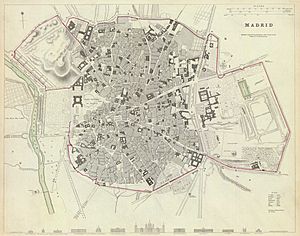Walls of Philip IV facts for kids
The Walls of Felipe IV (also known as the Royal Fence of Philip IV) were a large wall that surrounded the city of Madrid in Spain. They were built between 1625 and 1868. King Philip IV ordered them to be constructed. These walls replaced older ones that Madrid had outgrown.
These walls were not for defense, like a castle wall. Instead, they helped control who and what entered and left the city. This made it easier to collect taxes on goods coming into Madrid. The walls were made from brick, mortar, and packed earth. They were one of five different walls that surrounded Madrid at various times in history.
Contents
Where Were the Walls Located?
The Walls of Felipe IV followed a long, winding path around Madrid. They started near the Cuesta de la Vega. From there, they went along the Rondas of Segovia, Toledo, Valencia, and Atocha.
The walls also passed through important places like plaza del Emperador Carlos V, and along avenues such as Ciudad de Barcelona and Menéndez Pelayo. They continued along Calle de Alcalá, plaza de la Independencia, and streets like Serrano, Jorge Juan, plaza de Colón, Génova, Sagasta, and Carranza.
Then, the walls turned left at San Bernardo, going past Santa Cruz de Marcenado, Serrano Jover, la Princesa, Ventura Rodríguez, Ferraz, Cuesta de San Vicente, and Paseo de la Virgen del Puerto. They ran next to the Campo del Moro before connecting back to Cuesta de la Vega.
History of the Walls
Why New Walls Were Needed
During the time of King Philip IV, Madrid's population grew very fast. It was three times larger than during his grandfather's rule. By 1590, the city had grown beyond its older walls, the Walls of Philip II. Because of this growth, Madrid needed new boundaries.
The idea for new walls began in 1614. The king's main architect, Juan Gómez de Mora, was put in charge of the project. In 1617, Gómez de Mora drew out the new wall's path. He said that different parts of the wall should be built by skilled master architects.
Building and Purpose of the Walls
In 1625, Philip IV ordered the new walls to be built. They were made of brick, mortar, and earth. As mentioned, these walls were not for defense. Their main purpose was to control trade and people. They made sure that all food and products entering the city paid taxes. They also helped keep track of everyone coming into Madrid.
To pay for the construction, a special tax was put on wine. The walls were built in different sections around the city. Each section had an important gate. These gates and smaller openings (called portillos) were named after nearby buildings. The wall's path was not straight because it followed the shape of the land.
By 1650, the walls included areas like the Mountain del Príncipe Pío, the Buen Retiro, and the Hermitage of Atocha. A big problem with the walls was that they stopped the city from growing outwards. This meant people lived in crowded conditions for over 200 years.

Size and Demolition
The new walls were about 13 kilometers (8 miles) long. They enclosed an area of 500 hectares (about 1,235 acres). More than 150 hectares of this area belonged to the Buen Retiro Royal Site. This area included all of today's Centro district, plus Buen Retiro Park and the Los Jerónimos neighborhood.
Some parts of the walls were rebuilt in the 1700s. However, they were torn down in 1868 during the Glorious Revolution. People at the time saw them as a symbol of Queen Isabel II, and they wanted to remove such symbols.
Gates of the Walls
The walls had several exits from Madrid. There were five main "royal gates" where taxes were paid. These included Puerta de Segovia, Puerta de Toledo, Puerta de Atocha, Puerta de Alcalá, and Puerta de Bilbao.
There were also 14 smaller gates, or portillos, which were opened at different times. Some of these were Portillo de la Vega, Portillo de las Vistillas, Portillo de Gilimón, Portillo de del Campillo del Mundo Nuevo, Portillo de Embajadores, Portillo de Valencia, Portillo de Campanilla, Portillo de Recoletos, Portillo de Santa Bárbara, Portillo de Maravillas, Portillo de Santo Domingo, Portillo de del Conde Duque, Portillo de San Bernardino, and Portillo de San Vicente.
The main gates stayed open until 10 PM in winter and 11 PM in summer. After these times, people could still pass through a special checkpoint if needed. The smaller portillos opened at sunrise and closed at sunset, staying closed all night. Most of these smaller gates were not known for their fancy architecture, except for the Puerta de San Vicente, which was built by Sabatini.
Where Can You See Them Today?
You can still see small parts of the Walls of Felipe IV in two places today. One part is in the Jardines de Las Vistillas. It's part of a retaining wall near a staircase. This section is quite old and some parts have fallen down.
Another small piece is connected to the fire station near the Puerta de Toledo roundabout. This section is only about five meters long and has a special plaque to remember it. This part was rebuilt in the 1700s.
A third piece was found in 2009 during construction work on Calle de Serrano. There was also a fragment in the garden of the Seminario Conciliar. This piece was unfortunately taken down without permission. It was later rebuilt, but not with the original materials.
These remaining parts of the walls are important pieces of Madrid's history.
See also
 In Spanish: Cerca de Felipe IV para niños
In Spanish: Cerca de Felipe IV para niños




